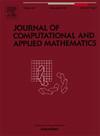非线性Abel-Volterra积分方程系统的高精度数值格式
IF 2.6
2区 数学
Q1 MATHEMATICS, APPLIED
Journal of Computational and Applied Mathematics
Pub Date : 2025-10-10
DOI:10.1016/j.cam.2025.117149
引用次数: 0
摘要
本文研究了一类包含弱奇异核函数的二阶非线性Abel-Volterra积分方程(SSNAVIEs)。为了有效地求解这些积分方程,我们提出了基于Jacobi多项式的Galerkin和迭代Galerkin (IG)方法。利用Banach收缩定理,证明了解的存在唯一性。此外,我们开发了数值算法来获得近似解,并对所提出的方法进行了全面的收敛和误差分析。对于Galerkin方法,我们建立了ON−q的一个收敛阶,而IG方法具有ON−2q的改进收敛率。据我们所知,这是第一个应用谱方法求解具有弱奇点的第二类非线性Volterra-Abel积分方程组的研究。为了验证我们的理论结果,我们进行了数值实验,验证了所提出方法的准确性和效率。本文章由计算机程序翻译,如有差异,请以英文原文为准。
Highly-accurate numerical scheme for a system of nonlinear Abel–Volterra integral equations
This study explores a system of second-kind nonlinear Abel–Volterra integral equations (SSNAVIEs) that involve a weakly singular kernel function. To effectively solve these integral equations, we propose Galerkin and Iterated Galerkin (IG) methods based on Jacobi polynomials. The existence and uniqueness of the solution are established using the Banach contraction theorem. Additionally, we develop numerical algorithms to obtain approximate solutions and conduct a comprehensive convergence and error analysis for the proposed methods. For the Galerkin method, we establish an order of convergence of , while the IG method exhibits an improved convergence rate of . To the best of our knowledge, this is the first study to apply spectral methods for solving systems of second-kind nonlinear Volterra–Abel integral equations with weak singularities. To validate our theoretical results, we perform numerical experiments, confirming the accuracy and efficiency of the proposed approach.
求助全文
通过发布文献求助,成功后即可免费获取论文全文。
去求助
来源期刊
CiteScore
5.40
自引率
4.20%
发文量
437
审稿时长
3.0 months
期刊介绍:
The Journal of Computational and Applied Mathematics publishes original papers of high scientific value in all areas of computational and applied mathematics. The main interest of the Journal is in papers that describe and analyze new computational techniques for solving scientific or engineering problems. Also the improved analysis, including the effectiveness and applicability, of existing methods and algorithms is of importance. The computational efficiency (e.g. the convergence, stability, accuracy, ...) should be proved and illustrated by nontrivial numerical examples. Papers describing only variants of existing methods, without adding significant new computational properties are not of interest.
The audience consists of: applied mathematicians, numerical analysts, computational scientists and engineers.

 求助内容:
求助内容: 应助结果提醒方式:
应助结果提醒方式:


